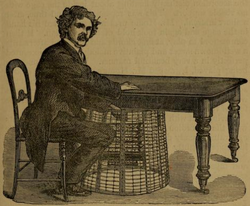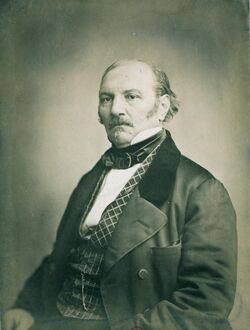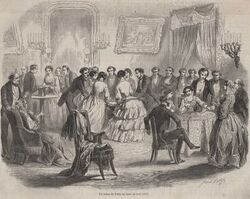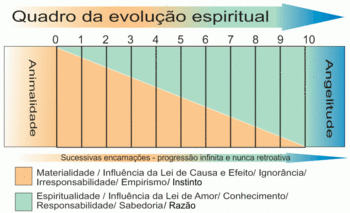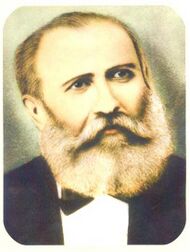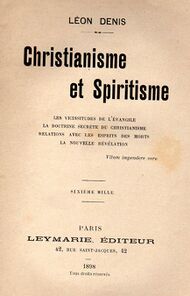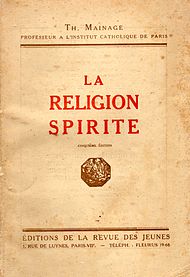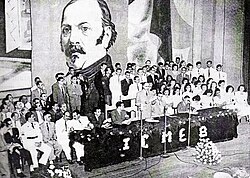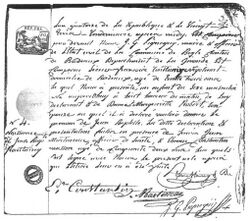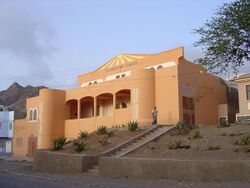Spiritism
Topic: Unsolved
 From HandWiki - Reading time: 50 min
From HandWiki - Reading time: 50 min
Template:Hatgrp Spiritism or Kardecism is a reincarnationist and spiritualist doctrine established in France in the mid-19th century by writer and educator Allan Kardec (a.k.a. Hippolyte Léon Denizard Rivail). It explains, from a Christian perspective,[1][2] the cycle by which a spirit supposedly returns to material existence after the death of the old body in which it dwelled, as well as the evolution it undergoes during this process. The concept also interacts with philosophical and scientific conceptions of the relationship between the physical and the moral.[3] Kardecism emerged as a new religious movement[4][3] out of spiritualism, the notions and practices associated with spiritual communication disseminated throughout North America and Europe since the 1850s.[3]
Kardec coined the term spiritism in 1857[5][6] and defined it as "the doctrine founded on the existence, manifestations, and teachings of spirits". Although not recognized as a science,[7] Kardec claimed that spiritism combines scientific, philosophical, and religious aspects,[8][9] seeking a better understanding not only of the tangible universe but also of the universe beyond transcendence.[10][11][12] After observing and analyzing the phenomena of table-turning, a kind of seance, he was intrigued by the fact that the table could move despite lacking muscles or provide answers without having a brain. It was allegedly the very agent causing the phenomenon who responded, "It is not the table that thinks! It is us, the souls of the men who have lived on Earth."[13] Kardec then proceeded to study this and other phenomena, such as "incorporation" and mediumship.[7]
The doctrine is based on five basic works, known as the Spiritist Codification, published by Kardec between 1857 and 1868. The codification consists of The Spirits' Book, The Mediums' Book, The Gospel According to Spiritism, Heaven and Hell, and The Genesis. Additionally, there are the so-called complementary works, such as What is Spiritism?, Spiritist Review, and Posthumous Works. Its followers consider spiritism a doctrine focused on the moral improvement of humanity and believe in the existence of a single God, the possibility of useful communication with spirits through mediums, and reincarnation as a process of spiritual growth and divine justice.[14]
According to the International Spiritist Council, spiritism is present in 36 countries, with over 13 million followers,[15] being most widespread in Brazil , where it has approximately 3.8 million followers, according to the data from the Brazilian Institute of Geography and Statistics, and over 30 million sympathizers, according to the Brazilian Spiritist Federation.[16][15] Spiritists are also known for influencing and promoting a movement of social assistance and philanthropy.[17] The doctrine has had a strong influence on various other religious currents, such as Santería, Umbanda, and the New Age movements.[3]
Definition
The term spiritism (from Old French spiritisme; spirit 'spirit' + -isme 'doctrine') emerged as a neologism, more precisely a portmanteau, created by the French educator Hippolyte Léon Denizard Rivail (known as Allan Kardec)[10][11][18] to specifically name the body of ideas systematized by him in The Spirits' Book (1857).[19]
To designate new things, new terms are needed. This is required by the clarity of language in order to avoid the confusion inherent in the variety of meanings of the same words. The words spiritual, spiritualist, spiritualism have a well-defined meaning. To give them another meaning, to apply them to the doctrine of Spirits, would be to multiply the already numerous causes of amphibology. (...) Whoever believes to have something within themselves beyond matter, is a spiritualist. However, it does not follow that they believe in the existence of Spirits or in their communications with the visible world. Instead of using the words spiritual, spiritualism, we employ, to indicate the belief we have just referred to, the terms Spiritist and Spiritism, whose form recalls the origin and the radical sense and which, for that reason, have the advantage of being perfectly intelligible, leaving to the word spiritualism its own meaning.—Allan Kardec
However, the use of the term, whose root is common to various Western nations of Latin origin[20][21] or Anglo-Saxon, quickly led to its incorporation into everyday usage to designate everything related to the alleged communication with spirits. Thus, today the term spiritism refers to various religious and philosophical doctrines that assert the survival of spirits after the death of the body, and primarily in the possibility of communicating with them, either casually or deliberately, through evocations or spontaneously.[22]
The term Kardecism is repudiated by some followers of the doctrine who reserve the word spiritism solely for the doctrine as codified by Kardec, affirming that there are no different branches within spiritism, and they refer to believers of various currents as spiritualists.[23] These followers believe that spiritism, as a doctrinal body, is singular, making the use of the term Kardecist spiritism redundant.[24][25][26] Thus, those who adhere to the teachings codified by Kardec in the basic works (with varying degrees of tolerance for concepts that are not strictly doctrinal, such as apometry) simply identify themselves as spiritists, without the addition of Kardecist.[23] The works themselves disapprove of the use of other expressions like Kardecist, stating that the codified teachings, in their essence, are not linked to the unique figure of a man, as is the case with Christianity or Buddhism, but rather to a collective of spirits whom they believe manifested themselves through various mediums at that historical moment and were expected to continue communicating, thus keeping the doctrinal body in a constant evolutionary process. However, another portion of followers considers the use of the term Kardecism appropriate.[27]
These expressions emerged from the need of some to distinguish spiritism (as originally defined by Kardec) from Afro-Brazilian religions such as Umbanda. The latter, discriminated against and persecuted at various times in Brazilian history, began to identify themselves as spiritists (at one point with the support of the Brazilian Spiritist Federation), in an effort to legitimize and consolidate the religious movement, due to the existing proximity between certain concepts and practices of it and Kardec's spiritism.[28]
Qualification as a science
Alexander Moreira de Almeida still attempts this legitimation,[29] even calling Kardec's approach "revolutionary."[30] However, the current scientific consensus considers parapsychology a pseudoscience,[31] disregarding the alleged paranormal phenomena that underpin spiritism, such as mediumship, reincarnation, obsession, table-turning, séances, automatic writing, spiritualist art, and typology. Critics of pseudoscience even define parapsychology as a "perversion", as parapsychologists claim that science cannot be the only privileged field that is exempt from the explanations they defend.[32] Animal magnetism (mesmerism) is also present in spiritist teachings, with constant references to mesmeric concepts such as magnetic fluids.[33][34] According to this hypothesis, some people could perform healings through "fluids". However, the animal magnetism hypothesis is considered pseudoscientific, as scientists have known since the second half of the 18th century that the alleged healings were purely psychosomatic, achieved through hypnosis, without any involvement of "fluids" or animal magnetism.[35][36][37]
According to Joseph McCabe, citing the claims of Arthur Conan Doyle about scientists confirming the alleged spiritual phenomena for 30 years, the mediums deceived the researchers. He considers that these deceptions led to the arrogant language of spiritualist literature.[38]
An article published in the British skeptical magazine The Skeptic also criticizes Spiritism for its association with ufology, parapsychology, animal magnetism, and other pseudosciences.[39][40]
Qualification as Christian
Kardec taught that "the teaching of the Spirits is eminently Christian."[41] In Posthumous Works, it is stated that Spiritism is "the only truly Christian tradition." Spiritist writers such as José Reis Chaves and Severino Celestino da Silva also claim that reincarnation was part of early Christianity until it was condemned by the Second Council of Constantinople.[42][43] This controversial thesis was popularized even earlier by Leslie Weatherhead but has also been questioned based on statements from the Church Fathers and the lack of references to reincarnation during that Council.[44] Agnostic scholar Bart D. Ehrman claims that evidence that early Christians believed in reincarnation is scant.[45] Christian theologian Norman Geisler claims that there is no evidence of reincarnation in the Bible. According to him, the famous text in John 9:2-3 reflects the rabbinic belief in prenatal sins, according to which a fetus could commit sin before birth, but not at reincarnation. He also dismisses other texts generally cited in support of reincarnation.[46]
The qualification of Spiritism itself as Christian has also generated controversy. Dr. Antônio Flávio Pierucci, professor at the Department of Sociology at the University of São Paulo (USP) and scholar of Brazilian religiosity, is one of those who affirm that Spiritism is "not a Christian religion."[47] There are no historical Christian doctrines within Spiritism, present in its main branches, such as the Trinity, the physical resurrection of Jesus, the inspiration of the Bible, and redemption. Due to these differences, many scholars consider it a form of neo-Christianity.[47] However, Spiritist writers argue that Spiritism is Christian because it promotes the teaching of loving one's neighbor.[3][4]
History
Early observations
According to followers and sympathizers of Spiritist doctrine, mediumistic phenomena is universal and has always existed, including abundant accounts in the Bible.[lower-alpha 1] Among others, Spiritists cite biblical mediumistic examples, such as Moses' prohibition of "consulting the dead", which would be evidence of the Jewish belief in this possibility, since something unrealizable is not prohibited;[48] the consultation of Saul, the first king of the ancient Kingdom of Israel, with the Witch of Endor, in 1 Samuel 28, who sees and hears the disembodied spirit of Samuel, the last of the judges of Israel and the first of the prophets recorded in the history of his people; and the communication of Jesus with Moses and Elijah on Mount Tabor in the Transfiguration of Jesus (Template:Cite bible).[49]
Ancient philosophy also provides examples: in Plato's Dialogues, he speaks about the daimon or genius that accompanied Socrates.[50][51]
Many Spiritists adopt March 31, 1848 (the beginning of the mediumistic events at the residence of the Fox sisters in Hydesville, USA) as the initial milestone of modern mediumistic manifestations, allegedly more ostensive and frequent than ever before, which led many researchers to delve into such phenomena.[52]
Allan Kardec
During the 19th century, there was a great wave of manifestations of mediumship in the United States and Europe.[53][54] These manifestations consisted mainly of strange noises, knocks on furniture, and objects that moved or floated without any apparent cause, as in the case of "table-turning". The supposed case of the Fox sisters in the United States stood out in the late 1840s.[55][56]
The true Spiritist is not the one who believes in the manifestations, but the one who benefits from the teachings given by the Spirits. Belief is of no use if it does not make one take a step forward on the path of progress and make one better towards their neighbor.—Allan Kardec; Spiritism in its Simplest Expression.[57]
Regarding his background, Kardec was a disciple of Pestalozzi and a member of various academic societies.[58] His main intention as a Spiritist was to provide some support to human spirituality at a time when science was advancing rapidly and religions were losing more and more followers. Kardec believed he had found a new way of thinking about reality that would bring together, in a balanced way, the rising science and the declining religion. He analyzed accounts of numerous mediumistic occurrences spread throughout Europe and the United States, unifying the information he interpreted in order to codify this type of practice and the teachings transmitted.[55]
Table-turning
The first manifestations of table-turning observed by Kardec involved tables lifting and knocking, using one of their legs, a determined number of knocks to respond yes or no, as agreed upon, to a proposed question.[60][61]
Despite the belief that supposed spirits or geniuses were moving the tables, Michael Faraday's scientific experiments published in 1853 showed that the movements were caused by the ideomotor effect and dismissed paranormal explanations for the phenomenon of table-turning.[62] The ideomotor effect also causes the movements observed in the so-called ouija board and the "cup game",[63] in which participants involuntarily move markers over letters and numbers and also attribute the movements to supposed spirits or geniuses.[64]
Analyzing these phenomena, Kardec concluded that there was nothing convincing about this method for skeptics because they could believe in an effect of electricity, whose properties were little known to the science of that time. Methods were then used to obtain more elaborate responses through the letters of the alphabet: the table knocking a certain number of times would correspond to the sequential number of each letter, thus forming words and sentences in response to the proposed questions.[65] Kardec concluded that the precision of the answers and their correlation with the questions could not be attributed to chance.[50] He also questioned the possibility of a muscular hypothesis (such as the ideomotor effect) being the cause of all the alleged movements and messages of the table-turning or other mechanical productions.[66][67][68] The mysterious being who responded in this way, when questioned about its nature, declared that it was a spirit or genius, gave its name, and provided various information about itself. Eventually, the phenomenon decreased in popularity and became anecdotal.[69]
Victor Hugo, during his exile on the island of Jersey (1851–1855), participated in numerous table-turning sessions with his friend Auguste Vacquerie and came to believe that he had made contact with deceased spirits, including his daughter Léopoldine (who had died by drowning) and great writers such as Shakespeare, Dante, Racine, and Molière.[70][71] Faced with experiences with table-turning, Hugo converted to spiritualism, and in 1867 called for science to pay attention to and take seriously the phenomena of table-turning:
The table that turns or speaks has been greatly ridiculed. Let us speak plainly. This mockery is unjustifiable. To replace examination with contempt is convenient but unscientific. We believe that the elementary duty of Science is to verify all phenomena because if Science ignores them, it has no right to laugh at them. A wise person who laughs at what is possible is very close to being an idiot. Let us be reverent before the possible, whose limits no one knows; let us be attentive and serious in the presence of the superhuman, from which we come and to which we are heading.[50][72]
Beliefs
Principles
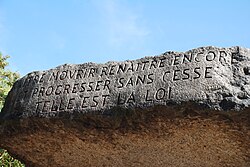
Born in the 19th century, on April 18, 1857, with the publication of The Spirits' Book, Spiritism was structured based on alleged dialogues established with disembodied spirits that, by manifesting through mediums, expounded on scientific, religious, and philosophical topics from the perspective of Christian morality, that is, with the principle of love for one's neighbor, bringing to light new perspectives on various subjects of great philosophical and theological relevance. Thus, one of the basic precepts of Spiritism was established, which is the importance of charity, (Motto: Outside of charity, there is no salvation),[73] understood as benevolence towards all, indulgence towards the imperfections of others, and forgiveness of offenses.[74]
The Spiritist doctrine aims to establish a dialogue between science, philosophy, and religion, with the goal of obtaining an original form that is both more comprehensive and profound, in order to better understand reality.[12][75] Kardec synthesizes the concept with the famous phrase: "Unshakable faith is only the one that can confront reason face to face in all epochs of humanity."[76]
According to the Spiritist philosopher Herculano Pires, "Spiritist Philosophy, as Kardec said, generically belongs to what we usually call Spiritualist Philosophy because its view of the Universe is not limited to Matter but extends to Spirit, which it considers as the cause of everything we perceive in the material plane. Embracing in its cosmological interpretation Spiritist Science and resulting in Spiritist Religion, Spiritist Philosophy encompasses the entire doctrine."[57][75]
Main foundations
The Spiritist doctrine, in general, is based on the following points (principles):[77]
- Existence and unity of God, rejecting the dogma of the Holy Trinity (As stated in the first question of The Spirits' Book - "God is the supreme intelligence, the primary cause of all things."[78]);
- The universe is God's creation, including all rational beings (Jesus, for example) and irrational, animated and inanimate, material and immaterial, which, in turn, are all destined for the law of progress;
- Existence and immortality of the spirit, understood as an intelligent individuality of divine creation that acts on matter through a "semimaterial" connection called perispirit, and, like the spirit, is indestructible;
- Spirit's return to matter (reincarnation), as many times as necessary, as the natural mechanism to achieve material and moral improvement. However, for the doctrine, the perfection that humanity is capable of achieving is relative, as only God possesses absolute perfection, infinite in all things. Spiritists reject belief in metempsychosis;[79]
- Concept of the "equal creation" of all spirits, "simple and ignorant" in their origin, and invariably destined for perfection, with identical aptitudes for good or evil, given free will;[80]
- Possibility of communication between incarnate (living) spirits and discarnate (dead) spirits, through mediumship (also known as communicability of spirits). This communication is carried out with the assistance of individuals with certain abilities - mediums - for example, via automatic writing (psychography);[81]
- Law of cause and effect, understood as a mechanism of universal ethical retribution for all spirits, according to which one's current condition is the result of one's past actions, and one's thoughts, words, and actions construct one's future on a daily basis ("One who sows good reaps good. One who sows evil reaps evil");[82]
- Plurality of inhabited material worlds: Earth is not the only planet with intelligent life in the universe, and reincarnation on other planets is possible;
- Jesus, created by God, is the guide and model for all of humanity.[83] According to Spiritism, Christian morality contained in the canonical gospels is the greatest ethical-moral guide that mankind possesses, and its practice is the solution to all human problems and the objective to be attained by humanity.[84]
- Outside of charity, there is no salvation.[85] According to Spiritism, charity consists of benevolence towards all, indulgence towards the imperfections of others, and forgiveness of offenses.[74]
Additionally, secondary characteristics can be mentioned:[86]
- The notion of individual responsibility's continuity throughout the spirit's existence;
- Progressiveness of the spiritual principle within the evolutionary process at all levels of nature;
- Total absence of a priestly hierarchy;
- Selflessness in the practice of good, meaning that one should not demand payment for charitable acts, nor should one do them with ulterior motives. All Spiritist practice is free, as guided by the moral principle of the gospel: "Freely you have received; freely give";
- Use of specific terminology and concepts, such as perispirit, mediumship, and Spiritist center;[87]
- Complete absence of exorcism, formulas, sacramental words, horoscopes, cartomancy, pyramids, crystals, amulets, talismans, worship or offering to images or altars, dances, processions, or similar acts, vestments, andors, alcoholic or hallucinogenic beverages, incense, and smoke, external practices, or any material signs;[88]
- Absence of institutionalized rituals, such as baptism,[89] worship, or ceremony to officiate marriage;[90]
- Encouragement of respect for all religions and opinions;[91]
- Having reasoned faith, rejecting blind faith that does not employ logical reasoning in its beliefs.[92]
Symbolism
Spiritism does not have an official symbol and prioritizes a denotative language. However, the vine branch depicted in The Spirits' Book – the only engraving used by Kardec in the Spiritist Codification – is considered by the doctrine as the perfect metaphorical image of the relationship between the spirit and the human body, due to this passage:[93]
You shall place at the head of the book the vine branch that we have drawn for you, for it is the emblem of the work of the Creator. All the material principles that can best represent the body and the spirit are contained in it. The body is the vine branch, the spirit is the liquor, the soul or the spirit linked to matter is the grape. Man refines the spirit through work, and you know that it is only through the work of the body that the Spirit acquires knowledge.—Preface of The Spirits' Book.
Works
Basic works
Below are some of the main works published by Allan Kardec:[94]
The work The Spirits' Book was published in 1857 and contains the fundamental principles of Spiritist Doctrine.[95] The Mediums' Book, or Guide for Mediums and Invokers, was published in 1861 and discusses the experimental and investigative nature of Spiritism, seen as a theoretical and methodological tool to understand a "new order of phenomena" that had never been considered by scientific knowledge: the so-called spiritist or mediumistic phenomena, which were believed to be caused by the intervention of spirits in physical reality.[96]
The book The Gospel According to Spiritism, published in 1864, evaluates the canonical gospels from the perspective of Spiritist Doctrine, addressing the application of Christian moral principles and religious matters such as the practice of worship, prayer, and charity with special attention.[97]
The work Heaven and Hell, or Divine Justice According to Spiritism, was published in 1865 and consists of two parts: in the first part, Kardec critically examines philosophical contradictions and inconsistencies with scientific knowledge, which he believes can be overcome through Spiritist paradigm of reasoned faith.[98] Topics covered include: causes of the fear of death, why Spiritists do not fear death, heaven, the Christian hell imitated from the pagan one, limbo, purgatory, doctrine of eternal punishments, penal code of the afterlife, angels, the origin of the belief in demons.[99] The second part contains dozens of dialogues that purportedly took place between Kardec and various spirits, in which they recount their impressions from the afterlife.[100]
The book The Genesis According to Spiritism, published in 1868, addresses various philosophical and scientific questions, such as the creation of the universe, the formation of worlds, the emergence of the spirit, and the nature of so-called miracles, according to the Spiritist paradigm of understanding reality.[101]
Complementary works
The book What Is Spiritism?, published in 1859, serves as an introductory and didactic work on Spiritism.[102]
The periodical Revue Spirite (in Portuguese, Spiritist Review), dedicated exclusively to Spiritism-related topics, was founded by Kardec and directed by him until his death in 1869. It has had the participation of several prominent figures in the doctrine and is currently published quarterly.[103]
The work Posthumous Works, published posthumously in January 1890 by the directors of the Parisian Society of Spiritist Studies, is a compilation of unpublished writings by Kardec, with annotations about the behind-the-scenes of the creation of the doctrine, aiding its understanding.[104]
Relationship with other segments of society
Science
Scientific method and "spiritual science"
The scientific investigation of the facts and causes of alleged mediumistic phenomena is the subject of intense study, mainly within the pseudoscience[105] of parapsychology.[106][107] Scientific investigations on mediumship and other "spiritual phenomena" advocated by Spiritism have taken place/take place even within the academic setting,[108][109][110] but although many scientists, including renowned ones,[111][112] have claimed to have provided evidence for the existence of such phenomena in their research through the scientific method, the existence of spirits is neither established nor proven.
Although not considered science in the strict sense due to being supported by philosophical and religious pillars, spiritist phenomena have been and still are the subject of study for a significant number of researchers (notably physicians and parapsychologists)[111][113][114][115][116] around the world. Among them, many have claimed to have strong evidence to corroborate several of the spiritist principles in a manner closely related to strict scientific standards.[111][112][117][118]
Many scientists and intellectuals have dedicated themselves to investigations of mediumship and its implications for the mind–body relationship, including: Kardec, Alfred Russel Wallace, Alexandre Aksakof, Cesare Lombroso, Camille Flammarion, Carl Jung, Cesare Lombroso, Charles Richet, Gabriel Delanne, Frederic Myers, Hans Eysenck, Henri Bergson, Ian Stevenson, J. J. Thomson, J. B. Rhine, James H. Hyslop, Johann K. F. Zöllner, Lord Rayleigh, Marie Curie, Oliver Lodge, Pierre Curie, Pierre Janet, Théodore Flournoy, William Crookes, William James, and William McDougall.[119][120]
Medicine
In terms of medicine, individuals with symptoms such as hearing or seeing spirits have been previously identified as having mental disorders, but with updates to the International Classification of Diseases (ICD), medicine now recognizes that these symptoms do not necessarily have pathological causes.[121]
The ICD in its tenth revision, ICD-10, includes under its item F.44.3 the so-called "Trance and possession states", defined as: "Disorders characterized by a transient loss of consciousness of one's own identity, associated with a perfect preservation of awareness of the environment." However, it explicitly states in the following clause: "Only involuntary and unwanted trance states should be included here, excluding those situations admitted in the cultural or religious context of the subject."[122]
In this sense, a distinction is made between the normal state of trance – for example, hypnosis, no longer considered an illness – and dissociative psychotic disorder, a psychiatric pathology. This item also excludes, among others, schizophrenia. The ICD also makes it clear that the trance states believed by spiritualists to originate from "spiritual possession" - common in religious environments - are not covered by the aforementioned item F.44.3 and are not considered pathological. Although the ICD explicitly recognizes such trance states by excluding them, it also does not attribute any trance to "spirits" as a cause, even though some spiritualist proponents insist otherwise.[123][better source needed]
The term "possession" in the aforementioned ICD item refers to states of excessive agitation, aggression, or even fury. Considering this meaning, the full reading of the associated item clearly implies the non-recognition of the "spiritual" cause (see clause). Another argument in favor of the initial assertion comes from the fact that the recognition of such a cause by the World Health Organization would require its compulsory inclusion in the ICD, as well as the need for specific treatment or monitoring, since these states of "possession" are readily recognized, first and foremost, by spiritualists themselves as situations often detrimental to the health of the "possessed" and requiring immediate "spiritual" treatment or accompaniment, which, according to their beliefs, is certainly provided by the respective groups or religious authorities qualified within their temples or meeting places. However, the World Health Organization has not defined, established, or even considered such treatments or accompaniments.[123][124][125]
The fourth edition of the Diagnostic and Statistical Manual of Mental Disorders (DSM-IV) included a warning against the mistaken interpretation of spiritual or religious experiences as mental disorders and distinguished, from mental disorders, another category of problems classified as "other conditions that may be a focus of clinical attention," including a specific subcategory called "spiritual or religious problems," to guide healthcare professionals in diagnosing and treating some potential non-pathological problems of patients.[126]
Recognizing the influence of the "state of mind" on health and well-being,[127] notable scientific institutions such as the World Psychiatric Association, American Psychological Association, American Psychiatric Association, and Royal College of Psychiatrists have sections dedicated to the relationship between health and spirituality.[127]
The relationship between Spiritism itself and medicine is profound, as evidenced by its presence in many spiritist books and the existence of the International Spiritist Medical Association, which brings together medical-spiritist associations from various countries.[128] Spiritism constitutes a vast international movement of charity and healthcare institutions, as evidenced mainly by the existence of such associations, numerous hospitals and spiritist centers, and a notable promotion of psychiatry and homeopathy.[129][130]
Dr. Adolfo Bezerra de Menezes, a spiritist and physician, wrote the classic book A Loucura sob Novo Prisma (Insanity from a New Perspective), seeking to relate the issue of mental disorders to Spiritism and promote the application of more effective treatment methods in the field of mental health.[131]
Currently, psychiatrist and parapsychologist Alexander Moreira-Almeida, coordinator of the "Section on Spirituality, Religiosity, and Psychiatry" of the World Psychiatric Association, is one of the leading figures in the scientific study of the relationship between health and spiritual experiences, especially mediumship.[120][132][133]
Other religions
There is no consensus among Spiritists as to whether Spiritism is a religion or not, despite the doctrine being classified as a religion in demographic surveys. This is due to the triple aspect of Spiritism, which allows it to be classified as a doctrine that aligns "science-philosophy-religion".[134][135] In the preamble of the book O Que É o Espiritismo? (What is Spiritism?), Kardec states that "Spiritism is, at the same time, a science of observation and a philosophical doctrine. As a practical science, it consists of the relations established between us and the Spirits; as a philosophy, it encompasses all the moral consequences that emanate from these same relations." Some still contest the religious aspect of Spiritism; however, in the book published by its codifier, titled O Espiritismo na sua mais simples expressão (Spiritism in its simplest expression),[9] he clearly asserts: "From a religious point of view, Spiritism is based on the fundamental truths of all religions: God, the soul, immortality, rewards and punishments in the afterlife, but it is independent of any particular cult. Its goal is to prove to those who deny or doubt that the soul exists, that it survives the body, and that it experiences, after death, the consequences of the good and evil deeds committed during corporeal life: the goal of all religions."[57] Kardec also clarifies that Spiritism is a religion in the Opening Address of the Annual Commemorative Session of the Day of the Dead (Society of Paris, November 1, 1868), where he states:
If that is the case, you may ask, is Spiritism a religion? Well, yes, undoubtedly, gentlemen! In the philosophical sense, Spiritism is a religion, and we take pride in it because it is the doctrine that establishes the bonds of fraternity and communion of thoughts, not on a mere convention, but on more solid foundations: the very laws of Nature.—Kardec[136]
At the International Spiritist Congress held in Paris in 1925, there was a proposal to remove the religious aspect from Spiritism, but the important French Spiritist philosopher Léon Denis opposed it with tenacity, even in his already weak physical condition of health.[50] According to Denis, Spiritism was not the "religion of the future" but rather the "future of religions".[137]
On the other hand, the Spiritist Doctrine affirms respect for all religions and doctrines, values all efforts for the practice of good, and claims to work for fraternity and peace among all peoples and all men,[138] although it firmly rejects, it must be reiterated, fundamental dogmas of other monotheistic religions. In the case of Christianity, the fundamental dogmas that stand out are the divinity of Christ, the Holy Trinity, salvation or justification by grace (more than by individual works or efforts), and the existence and importance of the Church as a spiritual entity, not just human.[139]
Christianity
The Spiritist doctrine adopts Christian morality[lower-alpha 2] despite its differentiated theological conceptions. According to Spiritists, the name given to the followers of Spiritism, Jesus Christ is the most elevated spirit to have ever incarnated on Earth.[140]
Spiritists (a widely used translation during the early decades of the 20th century for the French neologism spirite) or Spiritists consider themselves Christians and attribute to Spiritist doctrine the character of a Christian doctrine since they consider themselves followers of the moral teachings of Jesus. Spiritists base their defense of the Christian character of Spiritist doctrine on the fact that Allan Kardec argued that Christian morality, free from the dogmas of faith associated with it, would be the closest thing to a divine and rational code of ethics that humans possess. Spiritists argue that the dogmas were elaborated over the centuries by the Catholic Church and therefore it is not necessary to follow them to be a Christian. Furthermore, item 625 of The Spirits' Book states that Jesus is the greatest moral example available to humanity, although Spiritism denies any genuinely divine nature to him.[141]
Sermon on the Mount
The Beatitudes are nine teachings that Jesus delivered in the Sermon on the Mount, according to the New Testament (Template:Cite bible). For Spiritism, these teachings are of great importance, and they will now be presented from the Spiritist perspective.
Template:Cite bible. According to Spiritism, Jesus promises the kingdom of heaven to the simple and humble, referring to the moral qualities of the individual.[142]
Template:Cite bible. According to Spiritism, only in the afterlife can the compensations that Jesus promises to the afflicted on Earth be fulfilled. Faith in the future can console and instill patience in the spirit that endures the various terrestrial anomalies with calmness and resignation. However, it does not justify the causes of the diversity of evils, inequalities between vice and virtue, deformities, and natural disasters. The vicissitudes of life can be divided into two parts according to the Spiritist perspective: some have their explanations in the present life, while others are found outside of this life. This latter cause, in the Spiritist view, is explained by the plurality of existences in which the incarnated spirit pays for the evils it has committed in previous lives.[143]
The purity of the heart resembles the principle of simplicity and humility, excluding all ideas of pride and selfishness. According to Spiritism, the emblem of purity that Jesus takes in relation to children should not be taken literally, "Then they brought little children to Him, that He might touch them; but the disciples rebuked those who brought them. But when Jesus saw it, He was greatly displeased and said to them, 'Let the little children come to Me, and do not forbid them; for of such is the kingdom of God. Assuredly, I say to you, whoever does not receive the kingdom of God as a little child will by no means enter it'" (Mark 10:13-15). The spirit of the child, not yet able to manifest its tendencies towards evil, represents momentarily the image of innocence and purity resembling pure spirits. However, the actions [good or bad] taken by the spirit before incarnating gradually reflect in its behavior as an incarnated spirit. Therefore, as the incarnated spirit develops its physical structure, it also develops its psychic structure, which exhibits behavioral characteristics corresponding to the real conduct of the spirit itself.[144]
Template:Cite bible. According to Spiritism, Jesus makes meekness, moderation, gentleness, affability, and patience a law.[145]
Mercy consists of forgiving offenses, and for Spiritism, the sacrifice that pleases God the most is reconciliation with adversaries, as stated in Matthew 5:23-24.[146]
According to Spiritism, all Christian morality is summarized in this axiom:
Outside of charity, there is no salvation.
Reincarnation
For a large part of Christian religions, reincarnation is considered inconsistent with the teachings of the Bible, resurrection, the concept of salvation, and eternal damnation.[147][148] They cite the passage from the apostle Paul that determines the state of all humanity after death: "And as it is appointed for men to die once, but after this the judgment..."[149]
However, according to Spiritism, reincarnation was confused with the term resurrection, which literally means "return to life," resulting in various causes of ambiguity. The belief that man could come back to life is ancient and was part of Jewish doctrines, but it was not determined in what way this fact would occur since they only had vague and incomplete notions about the soul and its connection to the body.[150] According to some Spiritist followers, the apostle Paul in the aforementioned passage unveils the doubt regarding resurrection and dispels the belief in the return of the spirit to a body that is already dead to die a second time in it, especially when the elements of organic matter are already dispersed and absorbed by time, as all men die only once in each bodily existence.[151][152] They further affirm that the "judgment" refers to the individual state (not collective) that follows the death of the body (erraticity).[153] Although it does not deeply resolve the problem of ambiguity, several biblical passages emphasize reincarnation, according to Spiritism, such as Template:Cite bible[lower-alpha 5][154]
Law of Progress
The Final Judgment represents, according to Spiritism, the process of the "Regeneration of Humanity", in which the Earth will undergo a gradual physical and moral transformation, separating the spirits who wish to follow the path of good from those who remain in evil — an event symbolized in the Parable of the Judgment of the Nations in Template:Cite bible,[155] and in the Parable of the Wheat and the Tares in Template:Cite bible.[156][157] However, this disintegration will not cause the "imperfect spirits" to remain eternally in suffering, a situation similar to that found in Template:Cite bible,[158][159] because everything in the universe is destined for the law of progress.[160]
Mediumship
Judeo-Christian religions believe that with the Law given to Moses in the Old Testament, God had prohibited ancient Israel from communicating with the world of spirits and using "supernatural" powers granted by them. "...there shall not be found among you anyone who makes his son or his daughter pass through the fire, or one who practices witchcraft, or a soothsayer, or one who interprets omens, or a sorcerer, or one who conjures spells, or a medium, or a spiritist, or one who calls up the dead" (necromancy).[161] They also claim that this prohibition was confirmed in the New Testament through references in the Gospels and the book of Acts of the Apostles to "unclean spirits." The apostle Paul's statement asserts that whoever practices sorcery (or witchcraft, as the Greek term used is pharmakeia) "…shall not inherit the kingdom of God."[162]
The stance of Spiritist Doctrine proposes that biblical texts be critically evaluated when genuinely original, taking into account their symbolic level, considering the vocabulary resources and figures of speech available at the time and in subsequent translations.[163] Furthermore, it suggests that the spiritual context of the people of that time should be taken into account. According to Emmanuel (spirit), in a psychographic message through Xavier, the interchange with the deceased, during Moses' time, was made "with excessively crude and inferior material," and therefore, did not adequately accommodate mediumistic communication.[164]
Organizations
Brazilian Spiritist Federation
The Brazilian Spiritist Federation is a public utility entity[165] founded on January 2, 1884, in Rio de Janeiro. It is a civil, religious, educational, cultural, and philanthropic society whose purpose is the study, practice, and dissemination of Spiritism in all its aspects, based on the works of Allan Kardec's Codification and the canonical Gospels.[166]
International Spiritist Council
The International Spiritist Council (ISC) is an organization resulting from the union of representative associations of national Spiritist movements and currently has 35 associated countries. It was constituted on November 28, 1992, in Madrid, Spain. Its objectives are the promotion of fraternal union among Spiritist institutions in all countries and the unification of the worldwide Spiritist movement; the promotion of the study and dissemination of Spiritist Doctrine in its three basic aspects: scientific, philosophical, and religious; and the promotion of the practice of material and moral charity as taught by Spiritist Doctrine. The main event organized by the ISC is the World Spiritist Congress, held every three years.[167]
Pan-American Spiritist Confederation
The Pan-American Spiritist Confederation, founded on October 5, 1946, in Argentina, is an international institution that mainly brings together Spiritists from Latin America. CEPA has adherent and affiliated institutions in various countries and defends a secular view of Spiritism. The organization takes controversial positions among Spiritists, such as the dissociation between the doctrine and Christianity and the need to update Spiritism in light of science. Since October 13, 2000, the headquarters of CEPA has been in Porto Alegre, Rio Grande do Sul. CEPA's activities in Brazil are primarily carried out through events promoted by adherent institutions, such as the Forum of Free Thinking Spiritists and the Brazilian Symposium on Spiritist Thought.[168]
Demographics
From 1857, the year of the release of The Spirits' Book, to 1869, the year of Kardec's death, Spiritism gained 7 million followers.[169] According to data from 2005, Spiritism has about 13 million followers worldwide,[15] and according to data from 2010, Brazil – the country with the most followers[170] – has about 3.8 million Spiritists.[171][172] The International Spiritist Council (CEI) has 36 member countries.[173] Another international Spiritist organization, the Pan American Spiritist Confederation, brings together Spiritist institutions and delegates from 13 countries.[174][175][176]
Brazil
Spiritism arrived in Brazil in 1865 according to the Brazilian Spiritist Federation (FEB), although there are differing opinions on this matter.[177] as reported below:
Although since 1853 the country's newspapers already reported family gatherings for the production of phenomenons of mediumship, the Spiritism codified by Allan Kardec only arrived in Brazil around 1860 with the first copies of The Spirits' Book. It was in the year 1860 that the first Spiritist book published in Brazil appeared: Os Tempos são chegados ("The Times Have Come"), by French professor Casimir Lieutuad, a pioneering work that paved the way for the introduction of Spiritism in Brazil.[178]—Anuário Espírita 2006
Through Bezerra de Menezes[179] and Chico Xavier,[180] Spiritism had the opportunity to become popular throughout the country, spreading its teachings across a large part of the Brazilian territory. Brazil is the country with the largest number of Spiritists worldwide.[181] However, in the 19th century, the penal code of 1890 even banned the practice of Spiritism in Brazil and punished those who practiced the "crime" with up to 6 months in prison. Although socially tolerated, especially after the actions of the Brazilian Spiritist Federation (FEB) in the first decades of the 20th century, the practice ceased to be officially prohibited only with the promulgation of the penal code of 1940.[182][183] The FEB congregates approximately ten thousand Spiritist institutions,[184] spread across all regions of the country. There are also several Brazilian Spiritist associations for specific professions, such as the Brazilian Medical-Spiritist Association, Brazilian Association of Spiritist Psychologists, Brazilian Association of Spiritist Judges, Brazilian Association of Spiritist Artists, and Crusade of Spiritist Military.[50]
According to the Brazilian Census of 2010, Brazil had about 3.8 million Spiritists.[185] The state capitals with the highest percentage of Spiritists are Florianópolis (7.3%), Porto Alegre (7.1%), Rio de Janeiro (5.9%), São Paulo (4.7%), Goiânia (4.3%), Belo Horizonte (4.0%), Campo Grande (3.6%), Recife (3.6%), Brasília (3.5%), and Cuiabá (3.5%).[186] The IBGE considers the terms kardecism and Spiritism as equivalents in its census classification.[187]
As the third-largest religious group in Brazil, Spiritists also have the highest income and education levels among social segments, according to data from the same Census. Spiritists are strongly associated with acts of charity. They maintain asylums, orphanages, schools for the underprivileged, daycares, and other institutions for assistance and social promotion in all Brazilian states.[50] Allan Kardec is a well-known and respected figure in Brazil.[188] He is the most read French author in the country, with his books selling more than 25 million copies throughout the Brazilian territory. If we count other Spiritist books, all derived from the works of Kardec, the Brazilian Spiritist publishing market surpasses 4,000 titles already published and over 100 million copies sold.[189] The Spiritist theme constitutes the most successful literary market in Brazil, with Spiritist books leading the bestseller lists in the country's main bookstores.[50][190] According to the 2010 census, Spiritism experienced significant growth from 2000 to 2010, with an increase of over 60% in followers, going from 2.3 million to 3.8 million followers,[171] with the majority of them being between 50 and 59 years old (3.1%) and having the highest literacy rate (98.6%), the highest percentage of individuals with a completed university education (31.5%), and income above 5 minimum wages (19.7%), as well as the lowest percentage of individuals with no education (1.8%) and with incomplete primary education (15.0%).[172]
Cuba
After the legalization of religion in Cuba, there was a revival of Spiritism, which had been present in the Caribbean country since the 19th century.[191] According to data from the Ministry of Religions, in 2011, there were 400 Spiritist centers in Cuba, with an additional 200 being registered, making Cuba the second most Spiritist country in the world in terms of the number of centers. The Cuban Medical-Spiritist Association has the highest number of activists in the International Medical-Spiritist Association.[192]
Spain
In Spain , one of the great pioneers of Spiritism was Luis Francisco Benítez de Lugo y Benítez de Lugo, VIII Marquis of Flórida and X Lord of Algarrobo y Bormujos, who presented a bill for the official teaching of Spiritism, reading it on August 26, 1873.[193]
Mexico
In the decades of 1850–1860, Spiritism reached Mexico, attracting the intellectual elite with its proposals of modernism, anticlerical reform, and liberalism of free thought. General Refugio Indalecio González translated works by Kardec, publishing El Evangelio Según el Espiritismo in Spanish in 1872 in Mexico and, under the direction of the Sociedad Espírita Central de la República Mexicana, circulated spiritist magazines.[194] Among others, there was also the initial dissemination by utopian socialist Nicolás Pizarro Suárez.[195] In 1875, attention to Spiritism became heated in Mexico City when, in a positivist reaction after publications in the press, a debate was held between materialist and spiritualist students at the Liceo Hidalgo and Teatro del Conservatorio, considered by Zenia Yébenes Escardó as "the first philosophical controversy that was considered as such in Mexico."[194][196] In addition to its academic presence, popular Spiritism emerged, incorporating indigenous practices and local cults, with a strongly present folkloric imagery in the figure of Teresa Urrea, a spiritual healer who was supported by the spiritist Lauro Aguirre.[194][197] The feminist Laureana Wright, an already renowned writer, converted to Spiritism in 1889 to promote the debate of thought and women's equality, inspired by examples of female emancipation that she observed in other countries, and started holding sessions attended by various public figures, later becoming the president of the Sociedad Espírita Central.[198] Spiritist groups emerged in various locations, and after a brief decline at the end of the 19th century, attention on Spiritism intensified in the early 20th century through press coverage after Francisco Madero, who promoted it through works he distributed, organized congresses, and, inspired by allegedly psychographed letters, published a book that promoted the Mexican Revolution, becoming the president of Mexico for a short period until he was assassinated.[194][197]
Dissensions
Roustainguism
Since the 19th century, particularly in France and Brazil, there have been conflicts of opinion among Spiritists, mistakenly referred to as "Kardecists," and the so-called "Roustainguists," regarding the acceptance or rejection of the postulates of the work The Four Gospels or Revelation of Revelation, coordinated by Jean-Baptiste Roustaing, especially concerning the genesis of Jesus' body and the spiritual fall, which would cause the first incarnation of the spirits that failed. For Spiritists who accept the Kardec-Roustaing duo, Jesus had a "fluidic" body on Earth due to being a pure spirit, and thus, the genesis of that body was by His psychomagnetic will, characterizing Him as an agene.[199]
On the other hand, Spiritists who do not accept the work The Four Gospels, coordinated by Roustaing, believe that Jesus had a material body like any other incarnated human being, and its genesis was also similar, through the fusion of sperm and ovum.[200]
Furthermore, Roustaing's The Four Gospels explains that the spirits who failed due to atheism, pride, and selfishness incarnated in primitive worlds as "fleshy cryptogams" (creeping animals resembling slugs), which represents the doctrine of metempsychosis, not accepted by Spiritism since the doctrine of reincarnation states that the Spirit only reincarnates in the human kingdom (Humanity).[201]
Christian Rationalism
In the Brazilian city of Santos, a dissenting movement within the Spiritist movement emerged in 1910, which called itself "Rational and Scientific Christian Spiritism" and later became known as Christian rationalism, systematized by Luís de Matos and Luís Alves Tomás.[202]
Ramatism
In Brazil, since the second half of the 1950s, some Spiritist centers have followed the doctrine allegedly dictated by the spirit Ramatis (mainly embodied in the works psychographed by Hercílio Maes). They differ from traditional Spiritist centers due to a greater emphasis on universalism (common origin of religions) and the comparative study of Western and Eastern spiritualist religions and philosophies. It is also notable for a stronger influence of Eastern thought currents (such as Buddhism and Hinduism) and its proximity to the cosmogony of universalist spiritualism.[202]
Conscientiology
After ending the partnership with medium Chico Xavier in 1968, medium Waldo Vieira began his own research on the phenomenon called "consciential projection" (referred to as "spiritual unfolding" in Spiritism). Consequently, in 1987, he systematized the parascientific movement called Conscientiology.[203][204]
Christian Renewal
Emerging in Brazil as a dissent within the Spiritist movement since September 2002. While still following Spiritist Doctrine, it claims to do so with greater seriousness than the Brazilian movement itself, which is an argument used for its separation.[205]
Criticisms
Kardec's introductory book on Spiritism, What is Spiritism?, published only two years after The Spirits' Book, includes a hypothetical discussion between him and three idealized critics, "The Critic", "The Skeptic", and "The Priest", summing up much of the criticism Spiritism has received. The broad areas of criticism relate to charlatanism, pseudoscience, heresy, witchcraft, and Satanism. Until his death, Kardec addressed these issues in various books and his periodical, the Revue Spirite.
Later, the Theosophical Society, a competing new religion,[206] saw the Spiritist explanations as too simple or even naïve.[207]
René Guénon's influential book The Spiritist Fallacy criticized both the more general concepts of Spiritualism, which he considered to be a superficial mix of moralism and spiritual materialism, as well as Spiritism's specific contributions, such as its belief in what he saw as a post-Cartesian, modernist concept of reincarnation distinct from and opposed to its two western predecessors, metempsychosis and transmigration.[208]
The Catechism of the Catholic Church (paragraph 2117) states that "Spiritism often implies divination or magical practices; the Church, for her part, warns the faithful against it".[209]
In Brazil , Catholic priests Carlos Kloppenburg and Óscar González-Quevedo, among others, have written extensively against Spiritism from both a doctrinal and parapsychological perspective. Quevedo, in particular, has sought to show that Spiritism's claims of being a science are invalid. In addition to writing books on the subject,[210] he has also hosted television programs debunking supposed paranormal phenomena, most recently in a series that ran in 2000 on Globo's news program Fantástico.[211] Brazilian Spiritist Hernani Guimarães Andrade has, in turn, written rebuttals to these criticisms.[210]
In popular culture
Spiritism has been the subject of various non-literary works, such as soap operas, series, and films.[212]
Soap operas
The Brazilian soap opera Somos Todos Irmãos (1966), produced by the extinct TV Tupi, was inspired by the spiritist novel A Vingança do Judeu psychographed by the Russian medium Vera Kryzhanovskaia.[213] The soap opera A Viagem (1975), produced by TV Tupi, was inspired by the spiritist novels Nosso Lar and E a Vida Continua... psychographed by Chico Xavier, developing a complex plot addressing concepts such as mediumship, death, spiritual obsession, reincarnation, and others. Rede Globo conceived a remake of it in 1994.[214] The soap opera O Profeta (1977), produced by the extinct TV Tupi and also with a remake conceived in 2006 by Rede Globo, portrays the main character as a medium capable of predicting the future.[215]
More recently, the productions Alma Gêmea,[215] Escrito nas Estrelas,[216] Amor Eterno Amor,[217] Além do Tempo,[218][219] and Espelho da Vida also told stories related to Spiritism.[220]
Films
The Brazilian film Joelma 23º Andar (1979) was based on the work Somos Seis psychographed by Chico Xavier and is the first in the country with a spiritist theme, portraying the Joelma Fire tragedy, which left 179 dead and over 300 injured (February 1, 1974). Several other films followed, such as Bezerra de Menezes - O Diário de um Espírito (2006, seen by over 500,000 viewers),[221] Chico Xavier (2010, seen by about 3.5 million viewers in theaters),[221] Nosso Lar (also in 2010, seen by over 4 million viewers in theaters),[222] among others.
Series
The series The Dead Zone (2001), produced by Lionsgate Television and CBS Paramount Network Television, addresses paranormal phenomena, near-death experience, psychometry, precognition, and retrocognition. The series is based on the novel The Dead Zone, written by Stephen King, and the film The Dead Zone directed by David Cronenberg; [223]
The series Medium (2005), produced by NBC, features a protagonist who uses her mediumship to assist a public prosecutor in solving crimes. The series is based on the life of the American medium Allison DuBois, primarily on her work Don't Kiss Them Good-Bye;[224]
The miniseries A Cura (2010), aired and produced by Rede Globo, portrays the protagonist Selton Mello as a healing medium performing spiritual surgeries;[225]
The series A Gifted Man (2011), produced by CBS, tells the story of a renowned widowed surgeon who tries to change his personality after interacting with the spirit of his deceased ex-wife.[226]
See also
- Automatic writing
- Dowsing
- Mediumship
- Ouija
- Spiritualism
- List of Spiritualist organizations, spiritualists (Fox sister followers) not spiritists (Kardec followers)
- Chico Xavier
Notes
- ↑ Since ancient times, as in Template:Cite bible ("(Formerly in Israel, when a man went to inquire of God, he said, 'Come, let us go to the seer,' for he who is now called a prophet was formerly called a seer).'"), and as a common practice, as in Template:Cite bible ("The Spirit of the Lord will come powerfully upon you, and you will prophesy with them; and you will be changed into a different person.... Depending on the context, it was a risky practice, as illustrated in Template:Cite bible.
- ↑ Léon Denis wrote: "The ideal proclaimed by the voices of the invisible world is no different from that of the founder of Christianity." René Kopp also wrote: "Spiritism will be Christian, or it will be nothing." More details on this perception can be found in O Espiritismo Cristão (Christian Spiritism).
- ↑ The Gospel According to Spiritism. Chapter 15, Outside of Charity There Is No Salvation, The Greatest Commandment - Biblical Text - "But when the Pharisees heard that He had silenced the Sadducees, they gathered together. Then one of them, a lawyer, asked Him a question, testing Him, and saying, 'Teacher, which is the great commandment in the law?' Jesus said to him, 'You shall love the Lord your God with all your heart, with all your soul, and with all your mind.' This is the first and great commandment. And the second is like it: 'You shall love your neighbor as yourself.' On these two commandments hang all the Law and the Prophets" (Template:Cite bible)
- ↑ The Gospel According to Spiritism. Chapter 15, Outside of Charity There Is No Salvation, The Necessity of Charity, according to Paul (the Apostle) - Biblical Text - "Though I speak with the tongues of men and of angels, but have not love, I have become sounding brass or a clanging cymbal. And though I have the gift of prophecy, and understand all mysteries and all knowledge, and though I have all faith, so that I could remove mountains, but have not love, I am nothing. And though I bestow all my goods to feed the poor, and though I give my body to be burned, but have not love, it profits me nothing. Love suffers long and is kind; love does not envy; love does not parade itself, is not puffed up; does not behave rudely, does not seek its own, is not provoked, thinks no evil; does not rejoice in iniquity, but rejoices in the truth; bears all things, believes all things, hopes all things, endures all things. And now abide faith, hope, love, these three; but the greatest of these is love" (Template:Cite bible)
- ↑ The Gospel According to Spiritism. Chapter 4, No One Can See the Kingdom of God Unless Born Again, Resurrection and Reincarnation - Biblical Text - "When a man dies, shall he live again? All the days of my hard service I will wait, till my change comes. (Book of Job, Chapter 14, verses 10, 14) (ID. Version of the Greek Church) - Biblical Text - "But when a man dies, he is powerless; he breathes his last. Where is he? - If a man dies, can he live again? All the days of my struggle I will wait, until my relief comes." (Job 14:10-14) (ID. Translation by Le Maistre de Sacy) - Biblical Text - "When a man dies, he loses all his strength; he breathes his last. Where is he? - If a man dies, shall he live again? I will wait, all the days of my struggle, until change comes."
References
- ↑ Kardec 1857, p. 193, "The essential thing is that the teaching of the Spirits is eminently Christian; it is based on the immortality of the soul, on future punishments and rewards, on the justice of God, on the free will of man, on the morality of Christ. Therefore, it is not anti-religious".
- ↑ Arribas 2008, p. 34.
- ↑ 3.0 3.1 3.2 3.3 3.4 Clarke, Peter B. (2006). Encyclopedia of New Religious Movements. London and New York: Routledge. pp. 190–195. ISBN 978-0415267076.
- ↑ 4.0 4.1 Paul Christopher Johnson. "Possessed Persons and Legal Persons in Brazil". in Maryland Journal of International Law - University of Maryland. p. 187. https://core.ac.uk/download/pdf/80494598.pdf. Retrieved November 1, 2021. "Spiritism was a new religious movement spawned in the 1850s in part from technological developments like the telegraph and photography."
- ↑ MFESP 2012.
- ↑ Larousse 2012.
- ↑ 7.0 7.1 Pine 2008, pp. 13–37.
- ↑ Kardec 1859, p. 40.
- ↑ 9.0 9.1 Kardec 1861a, p. 15.
- ↑ 10.0 10.1 Lang 2008, p. 171.
- ↑ 11.0 11.1 Neto 2007, p. 622.
- ↑ 12.0 12.1 Vannuchi 2013, p. 250.
- ↑ Porto 2019.
- ↑ Lucchetti 2012, pp. 125-126.
- ↑ 15.0 15.1 15.2 Bernardo 2019.
- ↑ Schröder 2016.
- ↑ Calejo 2018.
- ↑ Lucchetti 2013, p. 746.
- ↑ FERN 2014.
- ↑ IBGE. Table 1.4.1 - Resident population, by household status and sex, according to religious groups - Brazil - 2010.
- ↑ OPA 2012.
- ↑ PeA 2015.
- ↑ 23.0 23.1 IPEPE 2007.
- ↑ Cumbria 2001.
- ↑ Rubin 2013.
- ↑ Millecco 1997.
- ↑ Moraes 2002.
- ↑ See: Sad episode that took place in 1953 Accessed on June 14, 2008.
- ↑ Almeida 2005, pp. 570-95.
- ↑ Alexander Moreira-Almeida (September 2, 2008). "Spiritism: The Work of Allan Kardec and Its Implications for Spiritual Transformation" (in English). Metanexus Institute. http://www.metanexus.net/essay/spiritism-work-allan-kardec-and-its-implications-spiritual-transformation. "In his revolutionary approach to spirituality"
- ↑ Stanford Encyclopedia of Philosophy, 2014
- ↑ Pigliucci 2013, pp. 145-163.
- ↑ Kardec, Allan (1991). Genesis. Rio de Janeiro: Feb. pp. 261–262.
- ↑ "Revista Espírita 1858 » Outubro » Emprego oficial do magnetismo animal". https://ipeak.net/site/estudo_janela_conteudo.php?origem=694&idioma=1&f=0.
- ↑ Spiegel, David (October 1, 2002). "Mesmer minus magic: Hypnosis and modern medicine". International Journal of Clinical and Experimental Hypnosis 50 (4): 397–406. doi:10.1080/00207140208410113. ISSN 0020-7144. PMID 12362955. https://doi.org/10.1080/00207140208410113. Retrieved November 12, 2020.
- ↑ "Hypnotism | Encyclopedia.com". https://www.encyclopedia.com/medicine/psychology/psychology-and-psychiatry/hypnotism#3045000547.
- ↑ "hypnosis | Definition, History, Techniques, & Facts" (in en). https://www.britannica.com/science/hypnosis.
- ↑ McCabe, Joseph (June 12, 1920). "Scientific Men and Spiritualism: A Skeptic's Analysis". The Living Age: 652–657. https://archive.org/details/sim_living-age_1920-06-12_305_3962/page/652/mode/2up?view=theater. Retrieved April 14, 2015.
- ↑ "Kardecism: the fringe spiritualist doctrine which became the soul of pseudoscience in Brazil" (in en-GB). January 15, 2021. https://www.skeptic.org.uk/2021/01/kardecism-the-fringe-spiritualist-doctrine-which-became-the-soul-of-pseudoscience-in-brazil/.
- ↑ "Pseudociências e a tradição espírita no Brasil" (in pt-br). https://revistaquestaodeciencia.com.br/index.php/apocalipse-now/2021/02/13/pseudociencias-e-tradicao-espirita-no-brasil.
- ↑ "I – Considerações sobre a Pluralidade das Existências" (in pt-BR). October 22, 2007. https://livrodosespiritos.wordpress.com/mundo-dos-espiritos/cap-5-consideracoes-sobre-a-pluralidade-das-existencias/i-consideracoes-sobre-a-pluralidade-das-existencias/.
- ↑ Tempo, O. (October 2, 2016). "Tirada do cristianismo, a reencarnação foi deixada na Bíblia" (in pt-BR). https://www.otempo.com.br/opiniao/jose-reis-chaves/tirada-do-cristianismo-a-reencarnacao-foi-deixada-na-biblia-1.1380247.
- ↑ Silva, Severino Celestino Da (September 11, 2020) (in pt). Analisando as Traduções Bíblicas. Ideia Editora Ltda. ISBN 9788575393598. https://books.google.com/books?id=V20eQAAACAAJ.
- ↑ Gudel, Joseph P.; Bowman, Robert M.; Schlesinger, Dan R. (Summer 1987). "Reincarnation — Did the Church Suppress It?". Christian Research Journal: 8–12.
- ↑ Ehrman, Bart D (April 9, 2022). "Did Early Christians Believe in Reincarnation?". https://ehrmanblog.org/did-early-christians-believe-in-reincarnation/.
- ↑ Geisler, Norman L.; Amano, J. Yutaka (1986) (in en). The Reincarnation Sensation. Tyndale House Publishers. ISBN 978-0-8423-5404-2. https://books.google.com/books?id=JCOCSAIzyesC.
- ↑ 47.0 47.1 "Espiritismo, que religião é essa?" (in pt-BR). https://super.abril.com.br/historia/espiritismo-que-religiao-e-essa/.
- ↑ Template:Cite bible
- ↑ Abib, D. Cultura Espírita no Brasil [Spiritist Culture in Brazil] . Brazilian Cultural Studies, North America, 224 07 2013.
- ↑ 50.0 50.1 50.2 50.3 50.4 50.5 50.6 Abib, D. CULTURA ESPÍRITA NO BRASIL/ SPIRITIST CULTURE IN BRASIL . Brazilian Cultural Studies, North America, 224 07 2013. p. 113.
- ↑ Valcicléia Pereira da Costa. "O "Daimon" de Sócrates: conselho divino ou reflexão?". PUC - Rio de Janeiro. http://www.puc-rio.br/parcerias/sbp/pdf/14-valcicleia.pdf. Retrieved 2015-02-11.
- ↑ "Sociedade Brasileira de Estudos Espíritas - História do Espiritismo". http://www.sbee.org.br/portal/doutrina-dos-espiritos/espiritismo/historia-do-espiritismo.
- ↑ Tyson 2011, p. 196.
- ↑ Podmore 1902, p. 188.
- ↑ 55.0 55.1 Alvarado, C. S.; Machado, F. R.; Zingrone, N. & Zangari, W. (2007). Perspectivas históricas da influência da mediunidade na construção de ideias psicológicas e psiquiátricas. Revista de Psiquiatria Clínica, v. 34, n. 1, p. 42-53.
- ↑ Doyle, Arthur Conan. (1926). A História do Espiritismo. Cassell And Company Ltd. pp. 56-85
- ↑ 57.0 57.1 57.2 Portal do Espírito: Objetivo do Espiritismo e seu tríplice aspecto - Celso Martins and Jayme Lobato Soares. Accessed on October 2, 2019.
- ↑ Eliane Garcia Rezende (2011). "Education: knowledge and flavor in the relationship between subjects". Pontoevírgula: 283. http://revistas.pucsp.br/index.php/pontoevirgula/article/viewFile/13913/10237.
- ↑ 59.0 59.1 L'Illustration Paris, 14 May 1853, https://commons.wikimedia.org/wiki/File:L%27Illustration,_Paris,_14_May_1853.djvu, retrieved 2020-02-29
- ↑ "CVDEE - Centro Virtual de Divulgação e Estudo do Espiritismo". http://www.cvdee.org.br/doutrina.asp. Retrieved October 2, 2019.
- ↑ Cuchet, William, Vozes do túmulo. Gira, espiritismo e da sociedade no século XIX, ed. du Seuil, 2012.
- ↑ Faraday, Michael (1853). "Experimental Investigation of Table-Moving". Journal of the Franklin Institute 56 (5): 328–333. doi:10.1016/S0016-0032(38)92173-8. http://www.sciencedirect.com/science/article/pii/S0016003238921738. Retrieved August 6, 2014. "Finally, I beg to direct attention to the discourse delivered by Dr. Carpenter at the Royal Institution on the 12th of March, 1852, entitled 'On the influence of Suggestion in modifying and directing Muscular Movement, independently of Volition':-which, especially in the latter part, should be considered in reference to table moving by all who are interested in the subject.".
- ↑ de Carvalho, Vera Lucia Marinzeck; (Espirito), Antonio Carlos. Copos Que Andam. São Paulo: Petit Editora e Distribuidor. pp. 12–20. ISBN 9788572530187. https://books.google.com/books?id=E-Av6IePIzkC.
- ↑ Podmore, Frank (1911). "Table-turning". Encyclopædia Britannica. 26 (11th ed.). p. 337; see para 2. "And Faraday devised some simple apparatus which conclusively demonstrated that the movements were due to unconscious muscular action".
- ↑ Bouchet, Christian, o Espiritismo, BA-BA coleção, Pardes, Puiseaux, 2004, p. 107.
- ↑ Kardec 1861b, p. 48.
- ↑ Kardec 1857, p. 28.
- ↑ Pimental, Marcelo Gulão. (February 2014). O Método de Allan Kardec para Investigação dos Fenômenos Mediúnicos (1854-1869). Juiz de Fora-MG: Universidade Federal de Juiz de Fora, Master's Dissertation for the Postgraduate Program in Health.
- ↑ Guia HEU. "As Mesas Girantes na França". guiaheu.com. http://www.guia.heu.nom.br/mesas_girantes.htm. Retrieved June 2, 2015.
- ↑ Monroe, John (1999). "Making the Seance "Serious": "Tables Tournantes" and Second Empire Bourgeois Culture, 1853-1861". History of Religions 38 (3): 219–246. doi:10.1086/463542. http://www.jstor.org/stable/3176353.
- ↑ Schneider, Maria do Carmo M (2002). "Victor Hugo: a face oculta de um gênio". Anais do Simpósio Internacional Victor Hugo, Gênio sem Fronteiras (Belo Horizonte, 2002). Universidade Federal de Minas Gerais. Archived from the original. Error: If you specify
|archiveurl=, you must also specify|archivedate=. https://web.archive.org/web/20230404043133/http://www.letras.ufmg.br/victorhugo/anais_main/schneider_01.htm. Retrieved April 14, 2015. Alt URL - ↑ Assouline, Pierre (April 5, 2012). "Même le guéridon de Victor Hugo vote Mélenchon" (in French). Le Monde des Livres. http://www.lemonde.fr/livres/article/2012/04/05/meme-le-gueridon-de-victor-hugo-vote-melenchon_1680605_3260.html. Retrieved April 14, 2015.
- ↑ Kardec, Allan, Espíritas Espíritas de 1862 Federação Espírita Brasileira. Editora – SP, 2011 pp. 32–35
- ↑ 74.0 74.1 Kardec 1864, p. 375.
- ↑ 75.0 75.1 Pires, José Herculano. Introduction to Spiritist Philosophy (1st edition). São Paulo: Ed. Paidéia, 1983; pp. 5–6, 9–11.
- ↑ Kardec 1864, p. 3.
- ↑ "Spiritism". http://www.oespiritismo.com.br/oque/index.php.
- ↑ Kardec 1857, p. 73.
- ↑ Mendes, Sônia (January 7, 2013). "Does metempsychosis belong to Spiritism?". Paracatu Notícias. http://paracatunoticias.com/?p=2262. Retrieved May 2, 2015.
- ↑ Xavier, Francisco Cândido (1964). Book of Hope. CEC – Comunnhão Espírita Cristã. pp. 21–22.
- ↑ Hellern, Victor; Notaker, Henry; Gaarder, Jostein. The Book of Religions. São Paulo: Companhia das Letras, 2000. ISBN 85-7164-994-4 p. 259.
- ↑ "Cause and Effect". Brazilian Spiritist Federation. 2013. https://www.febnet.org.br/wp-content/uploads/2013/05/Roteiro-17-Causa-e-Efeito.pdf. Retrieved October 12, 2019.
- ↑ Kardec 1857, pp. 380-381.
- ↑ Kardec 1864, pp. 17, 23-26.
- ↑ Kardec 1864, p. 210.
- ↑ Spiritism. Most frequently asked questions sent to FEB and their answers, based on Spiritist Doctrine.
- ↑ Zimmermann, Zalmino (2011). Theory of Mediumship. Allan Kardec. pp. 7–8.
- ↑ Kardec 1865, pp. 105-120.
- ↑ Xavier, Francisco Cândido (1938). EMMANUEL – 5th book by Francisco Cândido Xavier. Brazilian Spiritist Federation – 22nd edition. pp. 13–16, 177.
- ↑ Xavier & Emmanuel 1940, pp. 103-106.
- ↑ Kardec 1857, p. 386.
- ↑ Kardec 1864, p. 15.
- ↑ Kardec 1864, p. 66.
- ↑ Konrade. "Kardec's Testament". Biblia do caminho. http://bibliadocaminho.com/ocaminho/TKardequiano/TKP/TKIndexLivros.htm. Retrieved May 2, 2015.
- ↑ Kardec 1857, p. 190.
- ↑ Kardec 1861b, pp. 13-17.
- ↑ Kardec 1864, pp. 25-36.
- ↑ Kardec 1865, pp. 11-14.
- ↑ Kardec 1865, pp. 7-8.
- ↑ Kardec 1865, pp. 166-174.
- ↑ Kardec 1868, p. 190.
- ↑ Konrade. "What Is Spiritism?". Biblia do caminho. http://bibliadocaminho.com/ocaminho/TKardequiano/TKP/TKIndexLivros.htm#Qe1. Retrieved May 2, 2015.
- ↑ Konrade. "Spiritist Review". Biblia do caminho. http://bibliadocaminho.com/ocaminho/TKardequiano/TKP/TKIndexLivros.htm#Re. Retrieved May 2, 2015.
- ↑ Konrade. "Posthumous Works". Biblia do caminho. http://bibliadocaminho.com/ocaminho/TKardequiano/TKP/TKIndexLivros.htm#Op. Retrieved May 2, 2015.
- ↑ Goode, 2013
- ↑ Cook, E. W. (1986). The survival question: impasse or crux? . Journal of the American Society for Psychical Research 81(2), 125-139.
- ↑ Beischel, J., & Rock, A. J. (2009). Addressing the survival vs. psi debate through process-focused mediumship research. Journal of Parapsychology, 73, 71-90.
- ↑ "The VERITAS Research Program | Laboratory for Advances in Consciousness and Health" . Lach.web.arizona.edu.
- ↑ "Division of Personality Studies (DOPS), University of Virginia". http://www.healthsystem.virginia.edu/internet/personalitystudies/.
- ↑ "Núcleo de Pesquisa em Espiritualidade e Saúde". http://www.ufjf.br/nupes/.
- ↑ 111.0 111.1 111.2 Moreira-Almeida, Alexander; Santos, Franklin Santana (eds). Exploring Frontiers of the Mind-Brain Relationship. Springer, 2012. ISBN 9781461406471 pp. 191–202
- ↑ 112.0 112.1 Melton, J. G. (2001). Encyclopedia of Occultism and Parapsychology, 5th ed. Gale Group, 2001.
- ↑ "Society for Psychical Research". http://www.spr.ac.uk/main/. Retrieved 17 February 2010.
- ↑ "American Society for Psychical Research". http://www.aspr.com/. Retrieved 2 October 2019.
- ↑ "International Spiritist Medical Association". http://www.ameinternational.org/site/br/. Retrieved 2 October 2019.
- ↑ Caridade, Deus, Cristo e. "» Artigos CientíficosFederação Espírita Brasileira". http://www.febnet.org.br/blog/geral/pesquisas/artigos-cientificos/. Retrieved 2 October 2019.
- ↑ Beauregard, Mario et al. Manifesto for a Post-Materialist Science. OpenSciences.org. Retrieved on 21 December 2014.
- ↑ "Department of Psychiatry and Neurobehavioral Sciences – University of Virginia School of Medicine". http://www.medicine.virginia.edu/clinical/departments/psychiatry/sections/cspp/dops/publications-page. Retrieved 2 October 2019.
- ↑ Moreira-Almeida, Alexander. Research on mediumship and the mind–body relationship: a review of evidence. Rev. psiquiatr. clín. vol.40 no.6 São Paulo 2013.
- ↑ 120.0 120.1 Parana, Denise. Os avanços da ciência da alma . Revista Época, 19 November 2012.
- ↑ Moreira-Almeida, Alexander; Cardeña, Etzel. Differential diagnosis between spiritual experiences and psychopathology and mental disorders: a contribution from Latin American studies to ICD-11. Rev. psiquiatr. clín. vol.40 no.3 São Paulo 2013.
- ↑ "ICD-10 Version:2010". http://apps.who.int/classifications/icd10/browse/2010/en#/F40-F48. Retrieved 2 October 2019.
- ↑ 123.0 123.1 José Reis Chaves (14 January 2013). "A Organização Mundial de Saúde e sua coragem de dizer a verdade". O Tempo. https://www.otempo.com.br/opiniao/jose-reis-chaves/a-organizacao-mundial-de-saude-e-sua-coragem-de-dizer-a-verdade-1.719. Retrieved 2 October 2019.
- ↑ "Desobsessão - Francisco Cândido Xavier e Waldo Vieira - Federação Espírita Brasileira - Departamento Editorial - Rua Souza Valente, 17 CEP: 20941-040 - Rio - RJ - Brasil". pp. 2, 9–11.
- ↑ "International Classification of Health Interventions (ICHI)". http://www.who.int/classifications/ichi/en/. Retrieved 2 October 2019.
- ↑ Greyson, Bruce (2007). "Near-death experiences: clinical implications". Rev. Psiquiatr. Clín. 34 (suppl.1). ISSN 1806-938X. http://www.scielo.br/scielo.php?script=sci_arttext&pid=S0101-60832007000700015&lng=en&nrm=iso.
- ↑ 127.0 127.1 Moreira-Almeida, Alexander; Koenig, Harold G. and Lucchetti, Giancarlo. Clinical implications of spirituality to mental health: review of evidence and practical guidelines. Rev. Bras. Psiquiatr. [online]. 2014, vol. 36, n. 2 [cited 2014-12-18], pp. 176–182. Available from: http://www.scielo.br/scielo.php?script=sci_arttext&pid=S1516-44462014000200176&lng=en&nrm=iso. ISSN 1516-4446. http://dx.doi.org/10.1590/1516-4446-2013-1255.
- ↑ Olívia de Cássia - tribunahoje.com (1 February 2015). "Legalização do aborto: 79% são contra, segundo pesquisa nacional do Ibope". Tribuna Hoje - R7. http://www.tribunahoje.com/noticia/130699/cidades/2015/02/01/legalizaco-do-aborto-79-so-contra-segundo-pesquisa-nacional-do-ibope.html. Retrieved 5 February 2015.
- ↑ André Ricardo de Souza. Traços e embaraços do trabalho assistencial cristão. Estud. sociol (UNESP). Araraquara v. 18 n. 34 p. 182 January–June 2013
- ↑ Lucchetti 2012, pp. 124-135.
- ↑ Almeida, Moreira. "Textos espíritas históricos". Revista Espírita 2005: 570–595.
- ↑ Psiquiatra da ABP é eleito coordenador na Associação Mundial de Psiquiatria ; 10 October 2014. Associação Brasileira de Psiquiatria. Retrieved on 21 October 2014.
- ↑ UFJF: Mediunidade não está atrelada à esquizofrenia, diz pesquisa ; 10 May 2010. Universia - notícias. Retrieved on 25 March 2014.
- ↑ Alessandra Viana de Paiva. Espiritismo e cultura letrada: valorização do estudo pela doutrina Kardecista p. 6. (Universidade Federal de Juiz de Fora, 2009).
- ↑ Estudo Aprofundado da Doutrina Espírita - Cristianismo e Espiritismo. 2nd edition. Brasília [DF]: Federação Espírita Brasileira, 2010. pp. 8–9.
- ↑ Allan Kardec (1868). Revista Espírita. p. 491. https://www.febnet.org.br/ba/file/Downlivros/revistaespirita/Revista1868.pdf. Retrieved October 2, 2019.
- ↑ Pedro Fagundes Azevedo. Espiritismo é Religião . O Mensageiro. Accessed on March 3, 2015.
- ↑ "Introdução ao Estudo da Doutrina Espírita" (in pt-br). http://www.espirito.org.br/portal/codificacao/le/le-0-00.html.
- ↑ Bezerra de Menezes. Credo Espírita (1890).
- ↑ Kardec 1857, pp. 380–381.
- ↑ Obras Póstumas. 13th Edition, p. 121
- ↑ Kardec 1864, pp. 111-122.
- ↑ Kardec 1864, p. 79-104.
- ↑ Kardec 1864, pp. 123-134.
- ↑ Kardec 1864, pp. 135-140.
- ↑ Kardec 1864, pp. 141-152.
- ↑ "A Bíblia e a Reencarnação". http://www.chamada.com.br/mensagens/reencarnacao.html.
- ↑ "O que a Bíblia diz sobre reencarnação?". http://www.suaescolha.com/prforum/cienciasemilagres/reencarnacao2/.
- ↑ Template:Cite bible
- ↑ Kardec 1864, pp. 67-78.
- ↑ "Reencarnação na Bíblia". http://www.espirito.org.br/portal/artigos/paulosns/reencarnacao-na-biblia.html.
- ↑ "Hebreus 9:27 nega a reencarnação ou a ressurreição?". http://www.recantodasletras.com.br/artigos/3032125.
- ↑ A reencarnação é confirmada pela Bíblia. Cap.9,2. Accessed on October 2, 2019.
- ↑ Template:Cite bible, Template:Cite bible, Template:Cite bible, and Template:Cite bible
- ↑ Kardec 1868, pp. 327-354.
- ↑ "Projeto Gestão". http://www.sistemas.febnet.org.br/reformadoronline/pagina/?id=338.
- ↑ "Parábola do Joio e do Trigo". http://www.espirito.org.br/portal/artigos/calligaris/parabolas-02.html.
- ↑ "Parábola da Ovelha, da Dracma e do Filho Pródigo". http://www.espirito.org.br/portal/artigos/calligaris/parabolas/parabolas-21.html.
- ↑ "A Parábola do Filho Pródigo - Doutrina Espírita". http://www.doutrinaespirita.com.br/?q=node/47.
- ↑ Kardec 1857, pp. 351-363.
- ↑ Template:Cite bible
- ↑ Template:Cite bible
- ↑ Farias, Fátima (March 20, 2015). "O Espiritismo na Bíblia". in Portal do Espírito. https://espirito.org.br/artigos/espiritismo-biblia/.
- ↑ Xavier & Emmanuel 1940, Pergunta 274..
- ↑ "D47695impressao". http://www.planalto.gov.br/ccivil_03/decreto/1950-1969/D47695impressao.htm. Retrieved October 2, 2019.
- ↑ Correio Braziliense (January 31, 2014). "Espiritismo avança e atrai milhares de turistas ao médium João de Deus". Diário de Pernambuco. http://www.diariodepernambuco.com.br/app/noticia/brasil/2014/01/31/interna_brasil,487105/espiritismo-avanca-e-atrai-milhares-de-turistas-ao-medium-joao-de-deus.shtml. Retrieved May 2, 2015.
- ↑ International Spiritist Council (2012). "International Spiritist Council". cei.spirite.org. http://cei.spirite.org/pt. Retrieved September 14, 2019.
- ↑ "'O trigo e o joio' segundo o reformador da FEB". http://www.ofrancopaladino.pro.br/mat238.htm. Retrieved October 2, 2019.
- ↑ IstoÉ, ed (November 1, 2013). "O papa dos espíritas". http://www.istoe.com.br/reportagens/332712_O+PAPA+DOS+ESPIRITAS. Retrieved October 2, 2019.
- ↑ O Brasil é a capital mundial do Espiritismo
- ↑ 171.0 171.1 IBGE (June 29, 2012). "Censo 2010: número de católicos cai e aumenta o de evangélicos, espíritas e sem religião" (web). Sala de Imprensa › Censo Demográfico 2010 - Características gerais da população, religião... (Comunicação Social). http://www.ibge.gov.br/home/presidencia/noticias/noticia_visualiza.php?id_noticia=2170&id_pagina=1. Retrieved December 15, 2012. "Among the Spiritists, who went from 1.3% of the population (2.3 million) in 2000 to 2.0% in 2010 (3.8 million)..."
- ↑ 172.0 172.1 iG São Paulo (June 29, 2012). "IBGE: com maior rendimento e instrução, espíritas crescem 65% no País em 10 anos". Último Segundo. http://ultimosegundo.ig.com.br/brasil/2012-06-29/ibge-com-maior-rendimento-e-instrucao-espiritas-crescem-65-no-pais-em-10-anos.html. Retrieved December 15, 2012. "(...) followers of Spiritism have the highest proportions of people with completed higher education (31.5%) and literacy rate (98.6%), as well as the lowest percentages of individuals with no education (1.8%) and with incomplete elementary education (15.0%). Spiritism was also one of the religions that showed growth (65%) since the Census conducted in 2000: they went from 1.3% of the population (2.3 million) in 2000 to 2% in 2010 (3.8 million).(...) Also at the highest position when analyzing income, 19.7% of Spiritists declared themselves in the group of people with income above 5 minimum wages."
- ↑ Member Countries of the International Spiritist Council. Accessed on February 3, 2013
- ↑ "Instituições Adessas". www.cepainfo.org. http://www.cepainfo.org/index.php?option=com_content&view=article&id=64&Itemid=13&lang=pt. Retrieved November 12, 2015.
- ↑ "Instituições Afiliadas". www.cepainfo.org. http://www.cepainfo.org/index.php?option=com_content&view=article&id=71&Itemid=14&lang=pt. Retrieved November 12, 2015.
- ↑ "Delegados Especiais". www.cepainfo.org. http://www.cepainfo.org/index.php?option=com_content&view=article&id=310&Itemid=15&lang=pt. Retrieved November 12, 2015.
- ↑ Maldonado, Elaine Cristina. Machado de Assis e o Espiritismo: diálogos machadianos com a doutrina de Allan Kardec (1865-1896) (Master's degree in History thesis). São Paulo State University, Assis School of Sciences and Letters. p. 39. Archived from the original on April 2, 2015. Retrieved March 11, 2015.
- ↑ Anuário Espírita 2006, IDE Editora Ano XLIII N°43, Araras, São Paulo, 2006.
- ↑ Arribas 2008, p. 104.
- ↑ Langellier JP. Un homme insignifiant. Le Monde, May 12, 2010.
- ↑ iG (June 29, 2012). "IBGE: com maior rendimento e instrução, espíritas crescem 65% no País em 10 anos". http://ultimosegundo.ig.com.br/brasil/2012-06-29/ibge-com-maior-rendimento-e-instrucao-espiritas-crescem-65-no-pais-em-10-anos.html. Retrieved April 2, 2015.
- ↑ Giumbelli 2008.
- ↑ "Evolução histórica do Direito Penal". https://jus.com.br/artigos/932/evolucao-historica-do-direito-penal/2. Retrieved September 8, 2015.
- ↑ Paulo Borges - Assembleia Legislativa do Estado do Rio Grande do Sul. "Paulo Borges faz homenagem aos 150 anos da Doutrina Espírita no RS". April 19, 2007. http://www2.al.rs.gov.br/noticias/ExibeNoticia/tabid/5374/IdMateria/172656/language/pt-BR/Default.aspx. Retrieved April 2, 2015.
- ↑ IBGE.gov.br
- ↑ IBGE (2010). "censo2010". http://www.censo2010.ibge.gov.br/amostra/. Retrieved December 15, 2012.
- ↑ The classification of religions used by the IBGE is available at Censo_Demografico_2000/Anexos/CD_1, on this link
- ↑ Câmara homenageia 200 anos do nascimento de Kardec; October 28, 2004. Agência Câmara Notícias. Page visited on April 7, 2014.
- ↑ Missão da Federação Espírita Brasileira (FEB). "Allan Kardec". http://www.febeditora.com.br/blog/sobre-autores/allan-kardec. Retrieved July 20, 2013.
- ↑ Revista Época, "Leitores de Fé", June 26, 2009
- ↑ "Olmos and Paravisini-Gerbert". http://centropr.hunter.cuny.edu/sites/default/files/Journal/2003-2006/Vol_18_1_2006_spring/15_Cruz_p276-285.pdf.
- ↑ Santos, Cláudia. "Cuba, o segundo país mais espírita do mundo". Associação Médico-Espírita Internacional. http://www.ameinternational.org/site/br/?q=node/12. Retrieved October 2, 2019.
- ↑ Planas, Javier Alvarado (2 February 2016) (in es). Masones en la nobleza de España: Una hermandad de iluminados. La Esfera de los Libros. ISBN 9788490606124. https://books.google.com/books?id=wNJ_CwAAQBAJ&dq=Luis+Francisco+Ben%C3%ADtez+de+Lugo+espiritismo&pg=PT269. Retrieved February 15, 2022.
- ↑ 194.0 194.1 194.2 194.3 Mayo, C. M. (2014). Metaphysical Odyssey into the Mexican Revolution: Francisco I. Madero and His Secret Book, Spiritist Manual. Dancing Chiva. OCLC 1007384654. http://worldcat.org/oclc/1007384654.
- ↑ Illades, Carlos (2008) (in es). Las otras ideas: estudio sobre el primer socialismo en México, 1850-1935. Ediciones Era. ISBN 9789684116993. https://books.google.com/books?id=qSz9cKtiDF4C&pg=PA93.
- ↑ Batista, Luiz Felipe Santos (January–April 2017). "O debate científico em torno do espiritismo mexicano na segunda metade do século XIX. O exemplo do Liceo Hidalgo". Temporalidades – Revista de História 1 (23). ISSN 1984-6150. https://periodicos.ufmg.br/index.php/temporalidades/article/download/5745/pdf/.
- ↑ 197.0 197.1 Levya, José Mariano (2005) (in es). El ocaso de los espíritus: el espiritismo en México en el siglo XIX. Cal y Arena. ISBN 9789687711324. https://books.google.com/books?id=iwlZAAAAMAAJ.
- ↑ Vargas, Lucrecia Infante (2003). "De Espíritus, Mujeres y Igualdad: Laureana Wright y el Espiritismo Kardeciano en el México Finisecular. Vargas, Lucrecia Infante.". in Gutiérrez, Felipe Castro. Disidencia y disidentes en la historia de México. México: Universidad Nacional Autónoma de México. Instituto de Investigaciones Históricas. ISBN 970-32-1263-8. http://www.historicas.unam.mx/publicaciones/publicadigital/libros/407/407_04_12_LaurenaWright.pdf.
- ↑ The Ageneres, Allan Kardec, Revue Spirite, February 1859
- ↑ Anjos 2005, p. 111.
- ↑ Kardec 1857, p. 169.
- ↑ 202.0 202.1 "Doutrina Espírita". http://acordocoletivo.org/2011/06/19/doutrina-espirita. Retrieved 2 May 2015.
- ↑ Y. Shimizu (February 1998). ""Literatura Espírita XLV" (Works of Waldo Vieira)". Jornal "Mundo Espírita". FEP. Archived from the original. Error: If you specify
|archiveurl=, you must also specify|archivedate=. https://archive.today/20130306035815/http://www.mundoespirita.com.br/antigo/jornal/jornal98/fev10-1.htm. Retrieved 25 January 2013. - ↑ Sandra Jacqueline Stoll (2002). "Religion, science, or self-help? trajectories of Spiritism in Brazil". Rev. Antropol. (São Paulo) 45 (2). doi:10.1590/S0034-77012002000200003. ISSN 0034-7701.
- ↑ Revista Brasileira de História das Religiões – Pedro Paulo Amorim (2009). "A renovação cristã e a complexidade do campo religioso brasileiro no último quartel do século xx". Revista Brasileira de História das Religiões. http://www.dhi.uem.br/gtreligiao/rbhr/a_renovacao_crista_e_a_complexidade_do_campo_brasileiro.pdf. Retrieved 2 May 2015.
- ↑ Sender, Pablo. "Brief History of the Theosophical Society" (in en-gb). https://www.theosophical.org/ts-network/79-about-us-sp-709/society/1040-history-of-the-theosophical-society.
- ↑ Blavatsky, H. P. (1875-02-16). "Letter to Prof. Hiram Corson". Some Unpublished Letters of H. P. Blavatsky. Theosophical University Press Online Edition. http://www.theosociety.org/pasadena/corson/cors-lt1.htm. "In my eyes, Allan Kardec and Flammarion, Andrew Jackson Davis and Judge Edmonds, are but schoolboys just trying to spell their A B C and sorely blundering sometimes."
- ↑ Guénon, René (2004-06-25). The Spiritist Fallacy. Collected Works of René Guénon. trans. Alvin Moore, Jr. and Rama P. Coomaraswamy. Hillsdale, NY: Sophia Perennis Books. ISBN 978-0-900588-71-6.
- ↑ "Catechism of the Catholic Church". Holy See. https://www.vatican.va/archive/ccc_css/archive/catechism/p3s2c1a1.htm#2117.
- ↑ 210.0 210.1 Machado, Dr. Fátima Regina. "Parapsicologia no Brasil: Entre a cruz e a mesa branca" (in pt). Ceticismo Aberto. http://www.ceticismoaberto.com/paranormal/parapsicologia_brasil.htm.
- ↑ Guerrero, Cesar (2000-01-17). "Quevedo, o Mr. M de batina" (in pt). IstoÉ Gente. Editora Três. http://www.terra.com.br/istoegente/24/reportagens/rep_quevedo.htm.
- ↑ Cánepa, Laura. Notes for thinking about the wave of spiritist films in Brazil - In Revista Online de Comunicação, Linguagem e Mídias (University of São Paulo, 2013)
- ↑ A Vingança do Judeu (pdf) - Ed. Federação Espírita Brasileira
- ↑ Rito, Eloísa Sena. Representation of Heaven and Hell in the last chapter of the soap opera A Viagem . (Universidade Bandeirante de São Paulo, 2010)
- ↑ 215.0 215.1 Ribeiro, Raphael Alberto. Enclauded Sould: medical intervention practices, cultural representations, and everyday life in the Spiritist Sanatorium of Uberlândia (1932-1970), pg. 3. (Associação Nacional de História, 2007)
- ↑ Nascimento, Robéria Nádia Araújo. The "beyond" in Television Fiction: Religious Mediatization in Rede Globo's Teledramaturgy. (Universidade Federal da Paraíba, 2013)
- ↑ Castro, Natalia. 'Amor eterno amor' bets on spiritism and eternal bonds. In oglobo.globo.com, 05/03/2012. Retrieved on 11/26/2013.
- ↑ Pradella, Michele Vaz (September 29, 2015). "Vitória será mãe de Emília na segunda fase de Além do Tempo". clicRBS. Diário Gaúcho. http://diariogaucho.clicrbs.com.br/rs/entretenimento/noticia/2015/09/vitoria-sera-mae-de-emilia-na-segunda-fase-de-alem-do-tempo-4858614.html. Retrieved November 4, 2015.
- ↑ "Veja o antes e depois e os novos personagens da segunda fase de 'Além do Tempo'". Pure People. October 9, 2015. http://www.purepeople.com.br/noticia/veja-o-antes-e-depois-e-os-novos-personagens-da-segunda-fase-de-alem-do-tempo_a80101/1. Retrieved November 4, 2015.
- ↑ Bravo, Zean (July 15, 2018). "'Espelho da vida': new 6 p.m. soap opera has spiritist theme and scenes in Mariana". O Globo. https://oglobo.globo.com/cultura/revista-da-tv/espelho-da-vida-nova-novela-das-18h-tem-tematica-espirita-cenas-em-mariana-22887178. Retrieved October 3, 2018.
- ↑ 221.0 221.1 "A producer of body and soul" in istoe.com.br, April 5, 2012. Retrieved on June 10, 2012.
- ↑ Top 20, Potal Filme B .
- ↑ "The dead zone tv show". usanetwork.com. http://www2.usanetwork.com/series/thedeadzone/. Retrieved May 2, 2010.
- ↑ Mendonça, Martha. The new spiritism. Revista Época (ed. 424), 07/03/2006. Retrieved on 11/26/2013.
- ↑ Mattos, Laura. Globo invests in spiritism in a series with Selton Mello. In www1.folha.uol.com.br, 05/23/2010. Retrieved on 11/26/2013.
- ↑ The United States surrenders to the spiritist theme in 'A Gifted Man'. In ig.com.br
Bibliography
- Almeida, A. M. de; Neto, Francisco Lotufo (2005). "Spiritist Views of Mental Disorders in Brazil. Transcult Psychiatry". Transcultural Psychiatry 42 (4). doi:10.1177/1363461505058916.
- Anjos, Luciano dos (2005). Para Entender Roustaing. Bragança Paulista: Ed. Lachâtre. ISBN 85-88877-39-2.
- Bernardo, André (2019). "Como Allan Kardec popularizou o espiritismo no Brasil, o maior país católico do mundo". BBC Brasil. https://www.bbc.com/portuguese/brasil-47751865.
- Bismael B. Moraes (April 2002). "Kardecismo como Espiritismo: um Conceito". Centro Espirita Ismael. http://www.ceismael.com.br/artigo/kardecismo-como-espiritismo.htm.
- Calejo, Marco Antonio (2018). "Entidades espíritas ganham homenagens por boas iniciativas". ALESP. http://www.saopaulo.sp.leg.br/blog/entidades-espiritas-ganham-homenagens-por-boas-iniciativas/.
- "Centre National de Ressources Textuelles et Lexicales - Etymologie du Spiritisme". Ministério Francês de Ensino Superior e Pesquisa. 2012. http://www.cnrtl.fr/etymologie/spiritisme.
- "Diferenças entre o espiritismo e a umbanda". Núcleo Espírita Assistencial "Paz e Amor".
- "Diretriz doutrinária da Federação Espírita do RN". Federação Espírita do Rio Grande do Norte. 2014.
- "Esclarecimentos sobre o que é o Espiritismo". Instituto de Intercâmbio do Pensamento Espírita de Pernambuco. http://www.ipepe.com.br/esclarecimentos.htm.
- "Espiritismo". Dicionário infopédia da Língua Portuguesa, Porto Editora. 2019. https://www.infopedia.pt/dicionarios/lingua-portuguesa/espiritismo.
- Giumbelli, Emerson (2008). "Nação espírita: Embora tenha nascido na França, a religião de Kardec encontrou no Brasil sua verdadeira pátria".
- Kardec, Allan (2017). O Livro dos Espíritos. Rio de Janeiro: Federação Espírita Brasileira. ISBN 9788573288896.
- Kardec, Allan (2013). O que é o Espiritismo. Rio de Janeiro: Federação Espírita Brasileira. ISBN 978-85-7328-766-0.
- Kardec, Allan (1861). O Espiritismo na sua expressão mais simples. Rio de Janeiro: Federação Espírita Brasileira.
- Kardec, Allan (2015). O Livro dos Médiuns. Rio de Janeiro: Federação Espírita Brasileira.
- Kardec, Allan (2013). O Evangelho Segundo o Espiritismo. Rio de Janeiro: Federação Espírita Brasileira. https://febnet.org.br/wp-content/themes/portalfeb-grid/obras/evangelho-guillon.pdf.
- Kardec, Allan (2017). O Céu e o Inferno. Rio de Janeiro: Federação Espírita Brasileira.
- Kardec, Allan (1989). The Spirits' Book. Albuquerque, New Mexico: Brotherhood of Life. ISBN 978-0914732259.
- Kardec, Allan (1944). A Gênese. Rio de Janeiro: Federação Espírita Brasileira.
- Kardec, Allan (1875). Spiritualist philosophy. The spirits' book. Containing the principles of spiritist doctrine on: the immortality of the soul, the nature of spirits and their relations with men, the moral law, the present life, the future life, and the destiny of the human race — according to the teachings of spirits of high degree. Boston: Colby and Rich. (An 1875 translation of The spirits' book available online)
- Lang, Alice Beatriz da Silva Gordo (2008). "Espiritismo no Brasil". Cadernos CERU (USP) 19 (2). http://www.revistas.usp.br/ceru/article/view/11863/13640.
- Lucchetti, G.; Aguiar PR; Braghetta CC; Vallada CP; Moreira-Almeida A; Vallada H. (2012). "Spiritist psychiatric hospitals in Brazil: integration of conventional psychiatric treatment and spiritual complementary therapy". Cult Med Psychiatry 36 (1). doi:10.1007/s11013-011-9239-6.
- Lucchetti, G.; Jr., J. C. Daher; Jr, Iandoli D.; Gonçalves, J.P.; Lucchetti, A.L. (2013). "Historical and cultural aspects of the pineal gland: comparison between the theories provided by Spiritism in the 1940s and the current scientific evidence". Neuro Endocrinol Lett 34 (8). http://www.nel.edu/archive_issues/o/34_8/34_8_Lucchetti_745-755.pdf.
- Millecco, Luiz Antonio (1997). "Espiritismo ou Kardecismo?". http://www.espirito.org.br/portal/artigos/mundo-espirita/espiritismo-ou-kardecismo.html.
- Neto, Antonio Augusto Machado de Campos (2007). "A filosofia espírita. O direito natural. O direito justo". Revista da Faculdade de Direito da Universidade de São Paulo 102. http://www.revistas.usp.br/rfdusp/article/view/67773/70381.
- Pigliucci, Massimo; Boudry, Maarten (2013). "Goode, Erich. Paranormalism and Pseudoscience as Deviance". Philosophy of pseudoscience: reconsidering the demarcation problem. Chicago: The University of Chicago Press. ISBN 978-0-226-05182-6.
- Pine, Frances; de Pina-Cabral, João (2008). On the Margins of Religion. New York: Berghahn Books. ISBN 978-1-84545-409-8.
- Podmore, Frank (2011). Modern Spiritualism: A History and a Criticism. 1. Cambridge: Cambridge University Press. ISBN 978-1-108-07257-1.
- "Rio Grande do Sul tem maior adesão a religiões afro no país". O Observatório da Cidade de Porto Alegre. 2012.
- Rubin, Nani (2013). "Livro Reconstitui a Gênese do Espiritismo". O Globo.
- Schröder, André (2016). "Por que o espiritismo pegou tanto no Brasil". https://super.abril.com.br/cultura/por-que-o-espiritismo-pegou-tanto-no-brasil/.
- "Spiritisme". Larousse. http://www.larousse.fr/dictionnaires/francais/spiritisme/74242.
- "Spiritism/Kardecism". University of Cumbria. http://philtar.ucsm.ac.uk/encyclopedia/latam/kardec.html.
- Tyson, Philip; Jones, Dai; Elcock, Jonathan (2011). Psychology in Social Context: Issues and Debates. New Jersey: Wiley-Blackwell. ISBN 978-1-4443-9623-2.
- Vannuchi, Maria Lúcia (2013). "Um olhar sociológico sobre o espiritismo: trajetórias, ideias e práticas". Estudos de Sociologia (UNESP) 18 (34). https://periodicos.fclar.unesp.br/estudos/article/view/5983/4536.
- Xavier, Francisco Cândido; Emmanuel (2013). O Consolador. Rio de Janeiro: Federação Espírita Brasileira. ISBN 978-85-7328-781-3.
External links
 |
 KSF
KSF